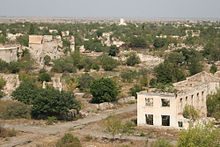Aghdam
39°59′35″N 46°55′50″E / 39.99306°N 46.93056°E
Ağdam | |
|---|---|
| Country | |
| Rayon | Agdam |
| Population (2008) | |
| • Total | 0 |
| Time zone | UTC+4 |
| • Summer (DST) | UTC+5 |
Ağdam (also, Agdam and Aghdam) is a town in the southwestern part of Azerbaijan and the capital of its Agdam Rayon. In July 1993, after heavy fighting, Agdam was captured by the forces of the Nagorno Karabakh Republic during its 1993 summer offensives. As the town fell, its entire population were forced to flee eastwards. Many were killed by Armenian soldiers. In the immediate aftermath of the fighting, the Armenian forces decided to destroy much of Agdam to prevent its recapture by Azerbaijan.[1] More damage occurred in the following decades when the deserted town was looted for building materials. Agdam is currently a ruinous, uninhabited ghost town.[2] The town's large mosque also survives in bad condition.[3]
Etymology
The city's name is of Azerbaijani origin and means White House, in which ağ means "white" and dam is house or "attic", thus referring to a bright sun-lit, white house which was given by Panah Ali Khan of Karabakh Khanate.[4]
Another possibility is that it was derived from ancient Turkic glossary meaning "small fortress". In the distant past, Turkic speaking tribes built small fortresses for their protection and safety.[4]
History

Agdam was founded in the 18th century but granted city status only in 1828.[5] Located 26 kilometers from Khankandi, prior to the Nagorno-Karabakh War, butter, wine (Industrial Association for processing of grapes - Agdam Brandy Company), machine factories and a railway station functioned in the city.[6][7]
Nagorno-Karabakh War

Agdam was the scene of fierce fighting during the Nagorno-Karabakh War. According to journalist Robert Parsons, Agdam was used by Azerbaijan as a base for attacks on Karabakh. However, the OSCE Minsk Group indicated that the capture of Agdam can not be justified in terms of self-defense, as the military situation was such that Agdam not a serious military threat to the Nagorno-Karabakh region.[8] During occupation of Agdam violations of the rules of war such as hostage-taking, indiscriminate fire and the forcible displacement of civilians were committed by Armenian forces.[9]As city fell, almost its entire population fled eastward and in the immediate aftermath of the fighting.[10]
The city is still currently used as a buffer zone by the Armed Forces of Armenia, meaning that Ağdam remains empty and decaying, usually banned for sightseeing.[11][12]
Post-war years
The ruined city once had a population of almost 40 thousand people,[13] but today it’s an almost entirely uninhabited ghost town.[14] All the houses have been destroyed, some by shells fired in the war, others looted for their bricks.[15][16]
One of the only buildings to remain structurally intact is Aghdam Mosque, which is today used as an Armenian cowshed, generating criticism from Azerbaijani and Turkish communities, who complained to Pope Benedict XVI about the mosque's current situation.[17]
Sport
Despite the invasion, the town is represented by a professional football team competing in the top-flight of Azerbaijani football - FK Qarabağ, currently playing in the Azerbaijan Premier League.[18]
Notable people
Cultural references
- The city of Agdam is the location of filming of the 2010 documentary "Caucasian Hiroshima" by Oscar Production of the Inam pluralism centre[19]
See also
References
- ^ Nicolas Holding, "Armenia with Nagorno Karabagh - Bradt Travel Guide", 2003, p200.
- ^ Города-призраки. Агдам – жертва мести, памятник глупости. Template:Ru icon
- ^ Отчет о велосипедном походе по Армении и Нагорному Карабаху 2007
- ^ a b "Agdam city". Ministry of Culture and Tourism of Azerbaijan. Retrieved 26 July 2010.
- ^ "Значение слова "Агдам" в Большой Советской Энциклопедии". Soviet Encyclopedia. Retrieved 26 July 2010. Template:Ru icon
- ^ "Агдам (Азербайджан)". Landmarkers.ru. Retrieved 26 July 2010. Template:Ru icon
- ^ Girchenko, Yuriy. "Юрий Гирченко. В Союзе все спокойно..." Retrieved 26 July 2010. Template:Ru icon
- ^ Parsons, Robert (3 June 2000). "Tug-of-war for Nagorno-Karabakh". BBC News. Retrieved 26 July 2010.
- ^ Human Rights Watch. Azerbaijan: Seven years of conflict in Nagorno-Karabakh. p.19
- ^ Paul, Amanda. "Agdam -- an Azerbaijani ghost town". Retrieved 18 May 2011.
- ^ Hannigan, Chris. "Ghost Towns: Ağdam, Azerbaijan". Retrieved 26 July 2010.
- ^ Chauffor, Célia. "Report: Agdam, ghost city". Caucaz Europenewz. Retrieved 26 July 2010.
- ^ Azerbaijani cities
- ^ "20 Abandoned Cities from Around the World". Daily Cognition. Retrieved 26 July 2010.
- ^ Esslemont, Tom (25 June 2009). "Karabakh guns still at the ready". BBC News. Retrieved 26 July 2010.
- ^ Armenians occupied Agdam cities listed among the ghosts
- ^ "Turks complain to Pope on vandalism in Karabakh church by Armenians". Retrieved 26 July 2010.
- ^ Adil Nadirov: «Bizi az qala döyüb öldürəcəkdilər" Template:Az icon
- ^ "Caucasian Hiroshima: Armenian atrocities on television". News.az. Retrieved 26 July 2010.
External links
- Fleeing from Aghdam. Refugee poem
- World Gazetteer: Azerbaijan – World-Gazetteer.com
- Pictures of the deserted town: "Abandoned War-Torn City of Agdam, Azerbaijan"
- Pictures of the deserted town: "Aghdam"

